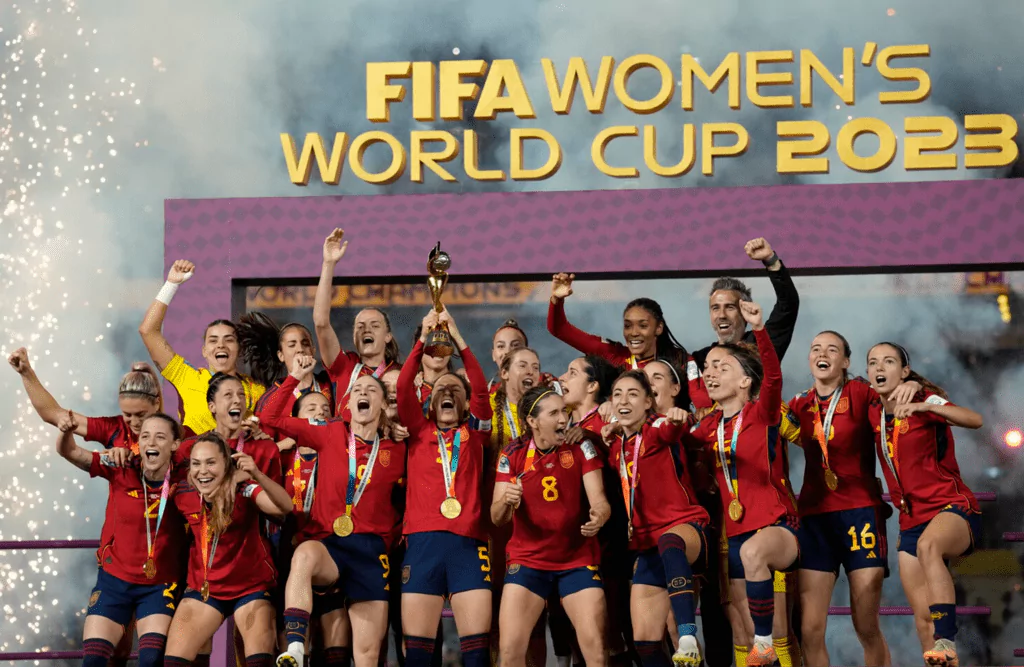Table of Contents
Explore the Women’s World Cup, a global phenomenon celebrating women’s excellence in football. Discover its empowering impact and unforgettable moments in this must-read article.

The Women’s World Cup – an electrifying spectacle that transcends borders, cultures, and languages, uniting nations under the banner of women’s football. This premier international tournament is not just about goals and victories; it’s a testament to the relentless spirit of female athletes who have defied stereotypes and limitations to shine on the grandest stage.
In the male-dominated world of sports, the Women’s World Cup stands as a symbol of equality, resilience, and empowerment. It’s a celebration of the sheer determination of women to excel in a field where they were once marginalized. This article takes you on a journey through the heart of the Women’s World Cup, unraveling its rich tapestry of history, remarkable moments, and the lasting impact it has had on women’s football and beyond.
As we delve into the intricacies of this tournament, you’ll witness how the Women’s World Cup has evolved from humble beginnings into a global phenomenon. It’s a story of ambition, progress, and the unyielding belief that women can conquer any field they choose.
Beyond the confines of the football pitch, the Women’s World Cup has been a catalyst for change in society itself. It’s not just about the matches; it’s about empowerment, equality, and the breaking of glass ceilings. This article is your passport to the world of women’s football, where passion meets purpose, and where every goal scored is a step towards gender parity.
Join us as we journey through the annals of this tournament, exploring its iconic moments, the extraordinary women who have graced its fields, and the lasting legacy it leaves behind. The Women’s World Cup is not just a competition; it’s a revolution. It’s a celebration of excellence, and it’s a call to action for a more inclusive and equal world.
So, fasten your seatbelts as we embark on this exhilarating journey through the Women’s World Cup, a tournament that has not only redefined football but also redefined what women can achieve in the world of sports.
Women’s World Cup: A Brief Overview
The Women’s World Cup is not just a football tournament; it’s a grand stage where female athletes from around the world showcase their incredible skills, determination, and passion for the beautiful game. This section provides an in-depth look at the origins, evolution, and format of the Women’s World Cup.
Origins and Evolution
The concept of a global women’s football championship had been simmering for decades before it finally came to fruition in 1991. In the early 20th century, women’s football was already making waves, with teams forming in various countries. However, it wasn’t until the ’90s that the dream of an international tournament became a reality.
The inaugural Women’s World Cup took place in China in 1991, marking a historic moment in the world of women’s sports. This tournament, which featured just 12 teams, was a modest beginning compared to the grandeur the Women’s World Cup would later attain. However, it was a crucial first step towards recognizing and celebrating the talents of female footballers on a global stage.
Since that pioneering moment in China, the Women’s World Cup has undergone a remarkable evolution. The number of participating teams has grown, the level of competition has intensified, and the tournament has become a major event on the global sports calendar. With each edition, the Women’s World Cup has not only showcased the excellence of women in football but also contributed to the growing popularity of the sport itself.
Tournament Format
One of the defining features of the Women’s World Cup is its inclusive format. In the current setup, 32 teams from different corners of the globe come together to compete for the coveted title. The tournament unfolds over the course of approximately a month, during which teams progress through group stages and knockout rounds, culminating in a thrilling final.
The format ensures that the best teams, regardless of their region or history, have an opportunity to shine. It’s a testament to the tournament’s commitment to promoting diversity and offering a level playing field for women’s football. As a result, every Women’s World Cup edition brings surprises, upsets, and moments of brilliance from both traditional football powerhouses and emerging talents.
In this section of the article, we’ll explore the tournament’s structure in greater detail, highlighting the stages, rules, and the drama that unfolds on the field. We’ll also touch upon the remarkable stories of teams and players who have left an indelible mark on Women’s World Cup history.
Key Moments in Women’s World Cup History
The Women’s World Cup has gifted us with a treasure trove of unforgettable moments that have not only defined the tournament but have also etched themselves into the annals of football history. These moments encapsulate the essence of passion, determination, and skill that female athletes bring to the game. In this section, we will delve into some of these iconic highlights that have left an indelible mark on the Women’s World Cup.
1999: USA’s Triumph
The year 1999 marked a pivotal moment in the history of the Women’s World Cup, as the tournament was hosted by the United States. It was a watershed moment that saw the sport of women’s football reaching new heights. The final match, which took place at the Rose Bowl in Pasadena, California, between the USA and China, was a testament to the tournament’s growing popularity.
The match ended in a dramatic penalty shootout, a fitting climax to a fiercely contested tournament. What made this moment truly iconic was not just the victory but also Brandi Chastain’s jubilant celebration after scoring the decisive penalty. Her iconic image, ripping off her jersey in sheer joy and triumph, remains one of the most enduring images in sports history.
Beyond the on-field drama, the 1999 Women’s World Cup final drew a record-breaking crowd, signifying the growing global interest in women’s football. It was a moment that showcased the potential of women’s sports to captivate audiences on a massive scale and inspire future generations of female athletes.
2011: Japan’s Victory
The 2011 Women’s World Cup in Germany witnessed another remarkable moment when Japan lifted the coveted trophy for the first time in its history. What made this victory extraordinary was not just the footballing prowess displayed by the Japanese team but also the emotional backdrop against which it unfolded.
Earlier that year, Japan had been ravaged by a devastating earthquake and tsunami. The triumph of the national women’s football team became a symbol of hope and resilience for the entire nation. Their journey through the tournament, marked by their skillful play and unwavering determination, resonated deeply with fans around the world.
The final against the United States was a nail-biting affair that went into penalties. Japan emerged victorious, and the images of their players holding the trophy high above their heads amidst tears and joy remain etched in the collective memory of football fans.
2019: Megan Rapinoe’s Dominance
The 2019 Women’s World Cup in France will be remembered for the rise of Megan Rapinoe, a talismanic figure who not only led the USA to victory but also used her platform to champion important social causes. Rapinoe’s performances on the field were nothing short of spectacular, as she showcased exceptional skills, leadership, and a knack for scoring crucial goals.
However, it was her unapologetic activism for gender equality and social justice that truly set her apart. Rapinoe used her status as a global football superstar to advocate for equal pay for female athletes, increased visibility for women’s sports, and LGBTQ+ rights. Her willingness to use her voice to bring about positive change made her an inspiration to millions of aspiring female footballers and activists alike.
In this section, we will dive deeper into these iconic moments, exploring the stories behind them and the profound impact they have had on the Women’s World Cup and the world of women’s football. These moments are a testament to the power of sport to inspire, unite, and drive positive change in society.
The Impact of the Women’s World Cup
The Women’s World Cup is not just about the matches played on the field; it’s a dynamic force that has reverberated far beyond the confines of the football pitch. This section explores the profound impact that the Women’s World Cup has had on women’s football, gender equality in sports, and its contribution to the global growth of the sport.
Empowering Women in Sport
The Women’s World Cup has been a powerful catalyst for empowering women in the world of sports. It has shattered age-old stereotypes that relegated women to the sidelines of football and, by extension, many other sports. The tournament has shown that women can excel in a sport traditionally dominated by men.
For aspiring female footballers, the Women’s World Cup has become a source of inspiration. It has given young girls worldwide a dream to aspire to, a dream of donning their national colors and representing their country on the world stage. The visibility and recognition that come with playing in the Women’s World Cup have encouraged more girls to take up football as a serious pursuit.
Female athletes who have participated in the tournament have become role models, proving that talent knows no gender. They have inspired future generations of women not just to play football but also to take on leadership roles in sports administration, coaching, and management.
Advancing Gender Equality
The Women’s World Cup has been at the forefront of advocating for gender equality in sports. One of the most significant areas where this battle is being fought is equal pay. Female athletes have long struggled for fair compensation compared to their male counterparts, despite their remarkable achievements on the field.
The Women’s World Cup has brought this issue to the forefront. Players and fans alike have voiced their support for equal pay, prompting discussions and policy changes in various countries and organizations. While the journey towards achieving equal pay is ongoing, the Women’s World Cup has played a pivotal role in pushing the conversation forward.
Additionally, the tournament has also led to increased visibility for women’s sports in general. More media coverage, sponsorships, and investments have flowed into women’s football, further bridging the gender gap in sports.
Global Football Growth
The Women’s World Cup has not only inspired young girls to take up the sport but has also fueled the growth of women’s football on a global scale. Countries that may not have had a strong tradition in women’s football have begun to invest in the development of their women’s teams.
Grassroots programs, talent scouting networks, and women’s football leagues have seen significant growth in response to the Women’s World Cup’s popularity. This growth ensures a brighter future for women’s football by nurturing talent from an early age and providing a pathway to professional careers.
In many nations, the Women’s World Cup has become a beacon of hope, not just for athletes but for entire communities. It has led to infrastructure improvements, better facilities, and increased support for women’s sports programs. As a result, women’s football has become a global force, with more countries vying for a spot in the tournament and striving for excellence in the sport.
FAQs about Women’s World Cup
As the Women’s World Cup has grown in popularity and significance, it has generated numerous questions from fans, newcomers, and curious observers alike. In this section, we aim to address some of the most frequently asked questions about the Women’s World Cup, shedding light on various aspects of this remarkable tournament.
Q: How often is the Women’s World Cup held?
A: The Women’s World Cup is held every four years, mirroring the schedule of the men’s FIFA World Cup. This quadrennial format allows time for teams to prepare, develop talent, and ensure that the tournament maintains its high standard of competition.
Q: Which country has won the most Women’s World Cup titles?
A: The United States holds the record for the most Women’s World Cup victories. As of the last update, they have clinched the title four times (1991, 1999, 2015, and 2019). Their consistent success has made them a dominant force in women’s football.
Q: How did the Women’s World Cup contribute to gender equality in sports?
A: The Women’s World Cup has been a driving force behind the advancement of gender equality in sports. Through this tournament, female athletes have gained visibility and recognition on a global scale. The advocacy for equal pay, improved facilities, and better support for women’s sports have all been championed by the Women’s World Cup, making it a crucial platform for promoting gender parity in the sporting world.
Q: What is the significance of the Women’s World Cup beyond football?
A: Beyond football, the Women’s World Cup symbolizes empowerment, breaking barriers, and fostering inclusivity. It serves as an inspiration to women and girls worldwide, encouraging them to pursue their dreams regardless of societal norms. The tournament has had a profound impact on society by challenging stereotypes and opening doors for women in various aspects of sports and leadership.
Q: Who is the all-time leading scorer in Women’s World Cup history?
A: Marta Vieira da Silva from Brazil holds the record for the most goals scored in Women’s World Cup history. Her remarkable talent and goal-scoring prowess have made her a legendary figure in women’s football.
Q: How has the Women’s World Cup influenced the development of women’s football?
A: The Women’s World Cup has had a profound influence on the development of women’s football by inspiring the growth of women’s leagues, grassroots programs, and talent scouting networks. The exposure and attention garnered by the tournament have led to increased investment in women’s football infrastructure and the nurturing of talent at all levels.





More Stories
Elevate Your Skills with a Pro Basketball Trainer
How to Learn from the Best Pickleball Instructors
Mastering Your Swing with the Ultimate Baseball Hitting Trainer